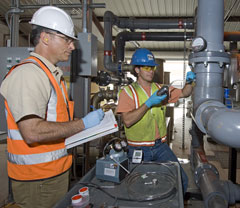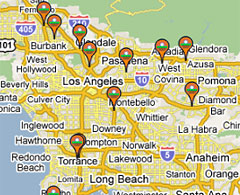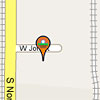Contact EPA Southern California
Pacific Southwest, Region 9
Serving: Arizona, California, Hawaii, Nevada, Pacific Islands, Tribal Nations
Superfund Sites in Southern California
| Southern California Quick Finder | ||||
|---|---|---|---|---|
| Asbestos Brownfields Children's Health | Disaster Preparedness Grants Indoor Air | Leaking Fuel Tanks Mold | Ports RCRA ID Numbers Vehicle Imports | TMDLs Air Water Infrastructure Wildfires |
Superfund is EPA's program to clean up the nation's uncontrolled hazardous waste sites. Once a site is assessed and determined to meet federal Superfund criteria, it is placed on the National Priorities List (NPL). The map at right shows all the current NPL sites in southern California.
In addition to cleaning up contamination throughout southern California, EPA has been working to reduce the amount of air pollution from Superfund clean up activities. EPA's Clean Up Clean Air Program lowers diesel emissions and greenhouse gas emissions by implementing innovative practices such as installing solar panels at the Pemaco site cleanup.
At Camp Pendleton, a Marine Corps base between San Diego and Los Angeles, cleanup crews are using clean diesel and biofuels to reduce particulate emissions from the cleanup by 27%. In addition, most of the soil will be hauled out by train, keeping 6,250 trucks off Southern California freeways—saving energy, reducing diesel emissions, and reducing traffic. Full Story »
Superfund Additional Resources
Landfill gas is being used to generate energy at the Operating Industries, Inc. Superfund site located 10 miles east of Los Angeles in Monterey Park. Six microturbines are generating enough power to supply about 70% of the landfill's energy needs, saving up to $400,000 per year, and reducing greenhouse gas emissions. Full Story »
There are several Superfund sites currently being cleaned up in southern California. Seven of these are highlighted on this page, with links to contacts and additional information:
- Del Amo Hazardous Waste Site, Torrance
- Halaco Engineering Company, Oxnard
- Montrose Chemical Corp, Torrance
- Palos Verdes Shelf
- Pemaco, Maywood
- San Fernando Valley, All Areas, County of Los Angeles
- San Gabriel Valley (Area 2): Aerojet, Baldwin Park
Del Amo Hazardous Waste Site, Torrance
From 1943 until 1972, the Del Amo facility site was a center of large-scale industrial activities, beginning with the production of synthetic rubber during World War II. Wastes were placed in six unlined pits and three unlined ponds on the site and subsequently were covered with soil.

Most of the 280-acre facility has since been developed as an industrial park. In 1984, contamination was discovered in the waste pit area in the upper levels of groundwater beneath the site. The deeper drinking water aquifer, which is not contaminated, supplies 34,000 people located within 4 miles of the site.
Groundwater and soils are contaminated with volatile organic compounds (VOCs), including benzene and toluene, polycyclic aromatic hydrocarbons (PAHs), and other semi-volatile organic compounds. Floating product, including benzene and petroleum products, also has been identified on top of the water table at various locations on the site.
At the waste pit area, a cap was built in 1999 and has been in operation since January 2000. The soil vapor extraction (SVE) system completed in August, 2006, has removed approximately 23,035 pounds (10,470.5 kilograms) of benzene via biodegradation and adsorption. In another location within the site, a hydraulic extraction pilot project has extracted approximately 20 gallons of pure product from contaminated groundwater.
Designs for a groundwater remediation system are underway by EPA and Responsible Parties and has included extensive groundwater modeling as well as field pumping tests. Feasibility studies are also underway to determine an approach for soil and non-aqueous phase liquid contamination at the site. The studies are anticipated to be completed in late 2008.
Halaco Engineering Company, Oxnard
Halaco Engineering Company operated a secondary metal smelter at this Oxnard site from 1965 to 2004, recovering aluminum, magnesium, and zinc from aluminum cans and other scrap metal. The site includes the former smelter and an adjacent 26-acre area where an estimated 700,000 cubic yards of smelter wastes were deposited. Immediately adjacent to the site is a portion of the Ormond Beach wetlands, which are one of the few remaining wetlands in the area and home to several endangered or threatened species.

Elevated levels of metals and radioactive thorium are present in the wastes and on site soils. Waste material has also moved into the underlying groundwater. In 2006, the site’s owners removed drums and chemicals. In 2007 EPA stabilized the waste pile, removed wastes from wetlands and improved site security.
EPA is conducting a study of the site’s surface water and groundwater as part of its Remedial Investigation to characterize the extent of the contamination in the site’s soils, sediments, surface water and groundwater, and identify the human health and environmental risks posed by site contamination. The studies are expected to continue into 2009.
Additional Resources:
- EPA Halaco Superfund Site
- Fact Sheet English (PDF) (4 pp, 186k) | Español (PDF) (4 pp, 175K)
Montrose Chemical Corp, Torrance
Montrose Chemical Corporation of California manufactured the technical grade of the pesticide DDT from 1947 until 1982 at a plant located at 20201 Normandie Avenue, Los Angeles, near the City of Torrance. The 13-acre former plant property is located in the Harbor Gateway, a narrow half-mile-wide strip of land extending southward from Los Angeles proper to the Los Angeles Harbor. In 1982, after Montrose ceased operations, the plant was disassembled and removed from the property. In 1985, Montrose regraded and paved the majority of the former plant property with asphalt. This temporary measure has prevented DDT in surface soils from being dispersed by the wind while EPA completes the selection of permanent cleanup remedies for the site. Approximately 3,000 people live or work within 1/4 mile of the former plant property. The Del Amo Superfund site is located immediately adjacent to the Montrose Chemical site and groundwater contamination from the two sites has commingled.
Palos Verdes Shelf
From 1947 to 1983, Montrose Chemical Corporation manufactured DDT at its plant near Torrance, California. The plant discharged wastewater containing the now-banned pesticide into Los Angeles sewers that emptied into the Pacific Ocean off White Point on the Palos Verdes Shelf (PVS). Since 2003, the Fish Contamination Education Collaborative (FCEC), a public outreach program of the EPA, has been working to protect the most vulnerable populations in Southern California from the health risks of consuming DDT contaminated fish off the Palos Verdes Shelf.

Through outreach to affected communities, anglers and businesses, FCEC provides education on the dangers of consuming contaminated fish, as well as recommended portioning and preparation guidelines. EPA is currently evaluating how to best address the pollution, focusing mainly on the areas of highest contamination.
Additional Resources:
- Fish Contamination Education Collaborative (FCEC)
- Cleaning up the Palos Verdes Shelf
- Site Update, February 2008 (PDF) (8 pp, 3.2M)
- Fact Sheet, June 2008 (PDF) (2 pp, 883K)
- Cruise Deployment Report 2007-2008 (PDF) (15 pp, 559K)
Pemaco, Maywood
Pemaco is a former chemical mixing facility located in Maywood, California, that operated between 1940s and 1991. The facility stored chemicals in over 30 underground storage tanks, 55 gallon drums and 6 above ground storage tanks. Unfortunately, some of these chemicals leaked into the surrounding soils and groundwater before the tanks could be removed from the site. In 1997, EPA began the cleanup process by tearing down the remains of the facility and removing the tanks and containers.

In 1998 a cleanup program was implemented using a soil vapor extraction system to treat the contamination. In addition, for 7 months between September 2007 and April 2008, EPA used an innovative new technology, an electrical resistive heating (ERH) treatment system, to help clean both groundwater and soil at the deeper subsurface depths. Successful implementation of the ERH system in the most highly contaminated areas on site has significantly decreased the size of the groundwater plume, and will help decrease the time it will take to cleanup the overall site.
The Pemaco site has also incorporated renewable energy into cleanup activities. Photovoltaic solar panels were installed to provide power to run vacuum pumps that draw contaminants out of the soil and groundwater. The solar panels produce about 4,500 kilowatt-hours of electricity annually. If this power had come from a fossil-fuel-burning power plant, it would have accounted for 4,311 lbs. of CO2 emissions. Full Story »
Additional Resources:
- Pemaco Groundwater Remediation Report (PDF) (52 pp, 5.9 M)
San Fernando Valley, All Areas, County of Los Angeles
In the early 1980s, testing revealed that the groundwater beneath large areas of the San Fernando Valley was contaminated with volatile organic compounds, primarily the solvents trichloroethylene (TCE) and perchloroethylene (PCE), which are widely used in industries such as metal plating, machinery degreasing and dry cleaning. In response, EPA selected and implemented three pump-and-treat remedies to help provide clean drinking water to the area. However, it was later discovered that in addition to the previously discovered pollution, the area also suffered from significant chromium contamination.
EPA has worked with the state to investigate several facilities that were suspected to be the source of that pollution. All Metals Processing Company, a metal plating shop in Burbank that had been abandoned by its owner, was determined to have the hazardous chemicals chromium, cadmium and cyanide leaking through the walls of their facility onto the ground 10 feet from a storm drain. EPA responded by removing the drums inside the facility, demolishing the building, and excavating the soil up to twenty feet deep in highly contaminated areas. To date, EPA continues to take an active role in the area’s cleanup efforts, focusing on the removal of chromium contamination sources before the chemical is able to seep into the ground water.
Additional Resources
- San Fernando Valley Feature Story
- San Fernando Valley Area 1
- San Fernando Valley Area 2
- San Fernando Valley Area 3
- San Fernando Valley Area 4
San Gabriel Valley(Area 2): Aerojet, Baldwin Park
The San Gabriel Valley Area 2 Superfund Site is one of four Superfund sites in the San Gabriel Basin aquifer, a critical source of drinking water for Southern California. Groundwater contamination was first detected in the San Gabriel Valley in 1979. Despite the widespread extent of contamination, the San Gabriel Basin aquifer continues to provide approximately 90 percent of the domestic water supply for the Valley's one and one-half million residents. In the 1980s and early 1990s EPA developed a basin-wide plan to set cleanup priorities, and led State and Federal efforts to develop the institutional framework necessary to address the contamination. After hundreds of hours of negotiations, active EPA mediation, assistance from professional third-party environmental mediators, multiple public hearings, and extensive media coverage, eight responsible parties and seven water agencies signed an agreement in March 2002. The eight companies agreed to pay for cleanup of the polluted groundwater over the next 15 years. The selected remedy, constructured between 1999 and 2000, is a groundwater pump and treat system capable of extracting and treating approximately 22,000 gallons per minute, or 32 million gallons per day, of contaminated groundwater.
The treatment plants capable of removing volatile organic compounds (VOCs), perchlorate, N-nitrosodimethylamine (NDMA), and other pollutants from the groundwater was recently featured on the cable televition show Modern Marvels. Cleanup costs to date exceed $150 million.









